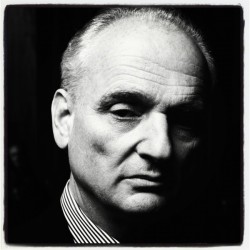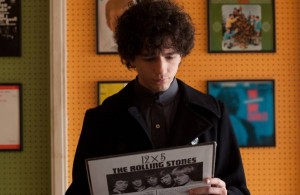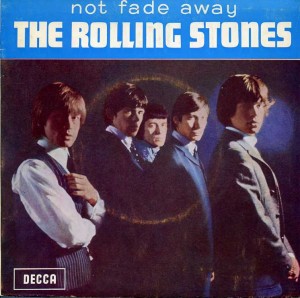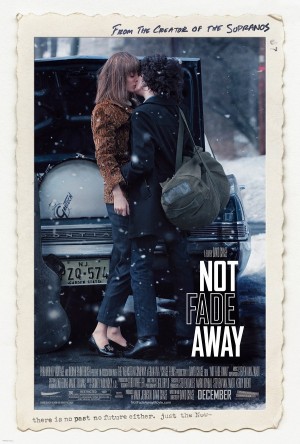 BY JONATHAN VALANIA Last week we sat down with Sopranos creator David Chase to talk about his new movie, Not Fade Away, a weedy coming-of-age dramedy about being young, horny and trying to be the Rolling Stones in the teenage wasteland of suburban New Jersey in the mid-’60s. There’s sex. There’s drugs. There’s rock n’ roll, in the form of an impeccably-curated soundtrack and convincing scenes of the band trying to kick out the jams in garages and basements. There’s James Gandolfini as the hey-you-kids-get-off-of-my-lawn father, shaking his fist at the longhairs from the wrong side of the generation gap — something even he eventually figures out. And the ending is just as wonderfully ambiguous as the fadeout of The Soprano’s, only the music’s better. Discussed: Kolchak: The Night Stalker, Orson Welles’ Touch Of Evil, the meaning of the end of Antonioni’s Blow-Up, Jagger/Richards, Chinatown, The Sex Pistols, Jonathan Richman & The Modern Lovers, Dylan’s wig and why he will have to answer for making Journey cool again when he meets his maker.
BY JONATHAN VALANIA Last week we sat down with Sopranos creator David Chase to talk about his new movie, Not Fade Away, a weedy coming-of-age dramedy about being young, horny and trying to be the Rolling Stones in the teenage wasteland of suburban New Jersey in the mid-’60s. There’s sex. There’s drugs. There’s rock n’ roll, in the form of an impeccably-curated soundtrack and convincing scenes of the band trying to kick out the jams in garages and basements. There’s James Gandolfini as the hey-you-kids-get-off-of-my-lawn father, shaking his fist at the longhairs from the wrong side of the generation gap — something even he eventually figures out. And the ending is just as wonderfully ambiguous as the fadeout of The Soprano’s, only the music’s better. Discussed: Kolchak: The Night Stalker, Orson Welles’ Touch Of Evil, the meaning of the end of Antonioni’s Blow-Up, Jagger/Richards, Chinatown, The Sex Pistols, Jonathan Richman & The Modern Lovers, Dylan’s wig and why he will have to answer for making Journey cool again when he meets his maker.
PHAWKER: First off, it is an honor to speak with you. Like everyone else on planet Earth, I loved The Sopranos, etc. etc. I’m sure you’ve heard this a million times so I won’t waste your time with idle flattery.
DAVID CHASE: You can never hear that enough.
PHAWKER: I was surprised to learn that you got your start as a writer for Kolchak: The Night Stalker, that showed scared the living shit out of me when I was a kid. I am still thinking about suing retroactively to recover the cost of all the Klonopin I’ve had to take as an adult as a result.
DAVID CHASE: Well, if we’d done as well as you say, I would’ve been farther along after that. But thanks.
PHAWKER: Why did you want to make this movie? I understand it is, in part, based on your own experience growing up in Jersey in the mid-’60s and playing in a garage band. But what do you think about the story of a north Jersey garage band,  inspired by the Rolling Stones, speaks to a larger audience?
inspired by the Rolling Stones, speaks to a larger audience?
DAVID CHASE: I love that music from that era so much and it changed my way of thinking. It was responsible for me thinking about being some kind of half assed artist. I used to joke that I wrote because I didn’t think the Rolling Stones got the attention they deserved. They credit The Beatles with the whole thing. The Beatles are fantastic and they were conquistadors, they started the whole thing off. But I felt that Mick and Keith were brilliant songwriters and for me that music is very evocative and emotional and I wanted to present that.
PHAWKER: Is the timeline of the movie roughly the timeline of your own experience growing up?
DAVID CHASE: Yeah. The timeline of the movie is about fall of ‘63 to the late winter of ‘68.
PHAWKER: I understand the inclusion of Antonioni’s Blow Up because that was a movie that would have been in theaters around that time, but I’m curious why you have the lead character watching Orson Welles’ Touch Of Evil on TV. And I say that as somebody who has a framed Touch Of Evil movie poster on the wall of his office.
DAVID CHASE: That’s when I first learned about Orson Welles, that movie came on TV. And that was quite a discovery
PHAWKER: What is your take on the ending of Blow Up, what do you think it all means?
DAVID CHASE: [laughs] I don’t discuss the ending of things.
PHAWKER: I heard about that, but I didn’t know it extended to the endings of other people’s work.
DAVID CHASE: Well, when I don’t know what I’m talking about I shut up. I don’t really know what it means. What do you think it means?
PHAWKER: Well, I used to think the mimes and clowns represented the coming counterculture of the 60s. But I watched it again recently and I’m not so sure it’s that simple.
DAVID CHASE: To me, it seemed like the end of Chinatown — you know, forget about it Jack, it’s Chinatown. It’s unknowable.
 PHAWKER: At the end there are a couple mimes on a tennis court pretending to play tennis with in invisible rackets and an invisible ball. And David Hemmings’ character, the photographer, is watching them and when they pretend that they knocked the ball over the fence, he plays along and pretends to pick it up and throw it back to them. The message being, life is absurd, don’t fight it, just go with the flow. Which reminds me of the ending of Not Fade Away. The main character could not be more fucked — he goes out to Los Angeles with his girlfriend and they go to a party and she runs off with Mick Jagger, leaving him behind with no ride and he starts walking home dejectedly and then he gets this smile on his face like he’s had some kind of revelation: Life is one long cosmic joke and you are doing it wrong if you don’t laugh.
PHAWKER: At the end there are a couple mimes on a tennis court pretending to play tennis with in invisible rackets and an invisible ball. And David Hemmings’ character, the photographer, is watching them and when they pretend that they knocked the ball over the fence, he plays along and pretends to pick it up and throw it back to them. The message being, life is absurd, don’t fight it, just go with the flow. Which reminds me of the ending of Not Fade Away. The main character could not be more fucked — he goes out to Los Angeles with his girlfriend and they go to a party and she runs off with Mick Jagger, leaving him behind with no ride and he starts walking home dejectedly and then he gets this smile on his face like he’s had some kind of revelation: Life is one long cosmic joke and you are doing it wrong if you don’t laugh.
DAVID CHASE: Yeah, I agree with that. I think he is happy to be where he is, by himself.
PHAWKER: While he is walking home a strange couple pulls up and offers him a ride. She is completely spaced out and has her face painted and the guy driving is wearing a hooded parka, he looks like an eskimo. But there is something unsettling about these people and he tells them ‘no, thanks.’ To me that couple represented all the peril and bad choices that your generation faced as the ‘60s wore on: Hard drugs, cults, Manson. Would that be accurate?
DAVID CHASE: Yeah that would be accurate, this innocent dream has turned dark.
PHAWKER: John Magaro plays Douglas, the protagonist in the movie, looks like a cross between Bob Dylan and Leonard Cohen, I’m guessing that’s no accident?
DAVID CHASE: That was unintentional. We had to put wigs on these guys because we shot the movie out of sequence, we would shoot a scene set in 1964 and then we’d shoot a scene set in 1968. It just so happens that the wig he wore made him look like Dylan. But we didn’t set out to do that.
PHAWKER: The scenes where the bands are playing are very convincing.
DAVID CHASE: That’s to [Little] Steven’s credit. He worked with the actors to make them believable as musicians.
PHAWKER: You licensed songs from the Beatles and the Stones, I know they don’t come cheap. How much did that cost?
DAVID CHASE: Uh, a lot. I really don’t want to get into the numbers but it was quite a lot. But we also got really good deals, a lot less than if we had to pay retail.
PHAWKER: Lastly, at the very end you use the Sex Pistols version of “Road Runner” by Johnathan Richman and the Modern Lovers. At the end of the movie the year is 1968, but that recording was made in 1976, eight years after. Please explain what I can  only assume is an intentional anachronism.
only assume is an intentional anachronism.
DAVID CHASE: I tried 150 songs in that scene and that version of that song just felt right. It just felt right. It’s a very garage-y feeling song. It reminds you of rock n roll at its rawest and its most suburban. The lyrics about the ‘Stop N’ Shop,’ it’s about the boring life in the ‘burbs somehow gaining purpose by listening to the music on the radio. That was very much what the movie is about.
PHAWKER: Why the Sex Pistols version instead of the Jonathan Richman version?
DAVID CHASE: The Sex Pistols version to me, I just like it. Plus the Sex Pistols are British and a continuation of the British Invasion thing. The Stones were very much the punks of their time. Plus, I just think the Sex Pistols rocked the shit out of everything they did.
PHAWKER: It also seems to foreshadow the fact that the whole coming age cycle and a generation finding their music is about to repeat itself in the form of punk.
DAVID CHASE: It was foreshadowing. It was about to happen all over again with Elvis Costello, The Clash and The Pretenders — it was another big flowering of music from Britain.
PHAWKER: I will leave you with this, David. In the afterlife, you will have to answer for making Journey popular again.
DAVID CHASE: Yeah, I know. I’ve been answering for it in this life, too.
Santa Monica Civic Auditorium October 29th, 1964.

